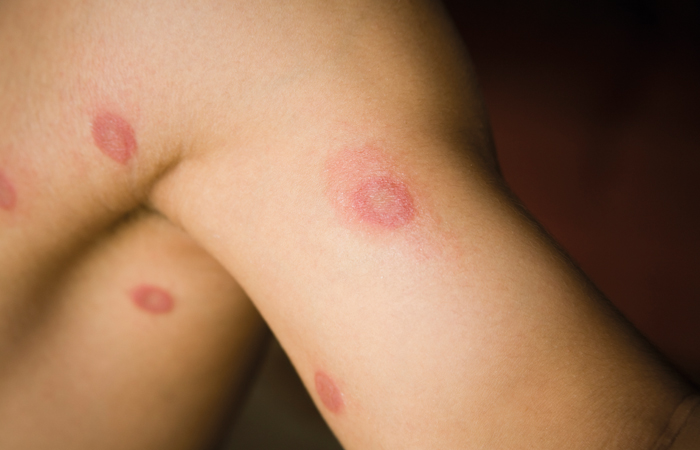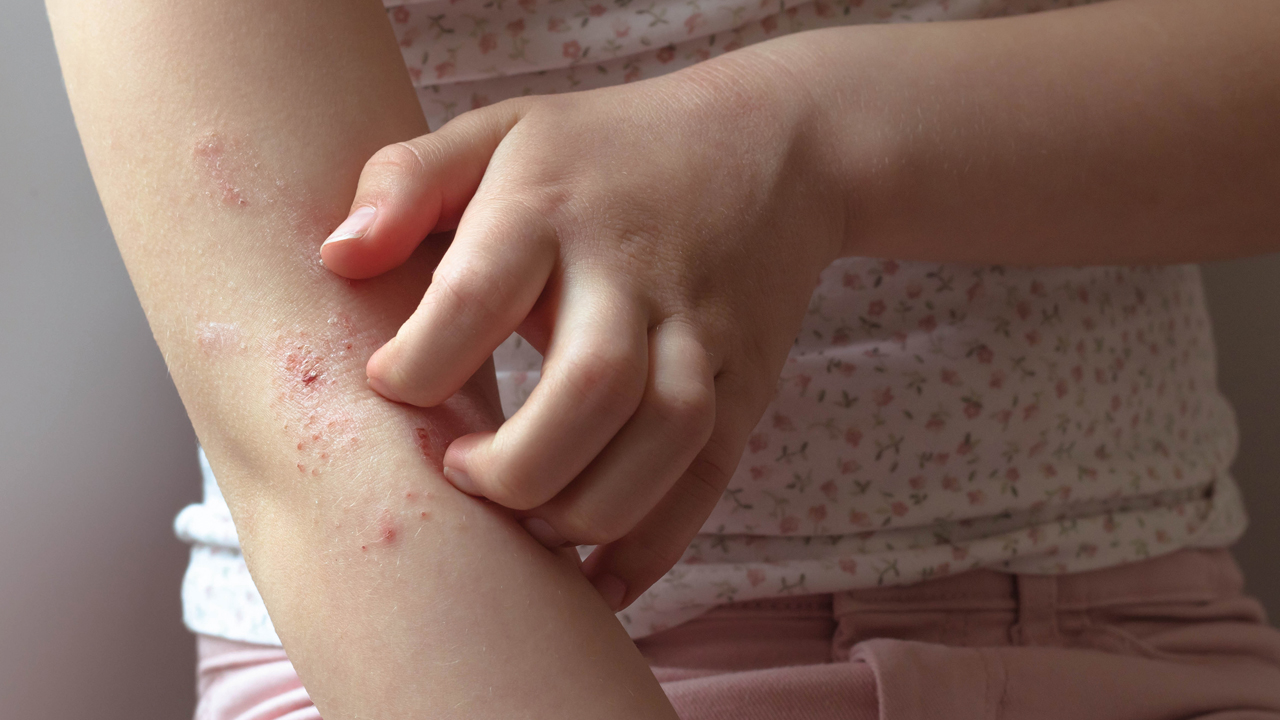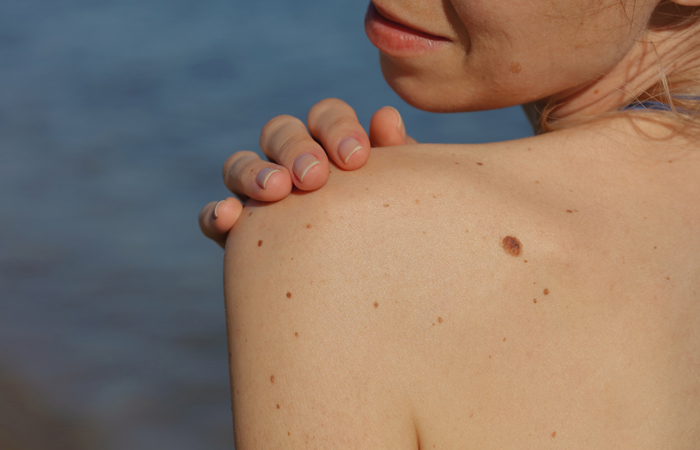In Conditions
Follow this topic
Bookmark
Record learning outcomes
As our largest organ, skin accounts for around 15 per cent of an individual’s body weight and has several important functions, from regulating temperature to protecting against germs. Many people, however, experience problems with their skin at some stage in their lives.
“Some 60 per cent of people in the UK currently have a skin condition or have previously had a skin condition,” says Dr Rishika Sinha, consultant dermatologist and British Skin Foundation spokesperson. “According to a recent study published in 2022 [in the Journal of the European Academy of Dermatology and Venereology], the most common skin conditions across 27 European countries including the UK were fungal skin infections (8.9 per cent), acne (5.4 per cent), and atopic dermatitis or eczema (5.5 per cent).”
This feature outlines several common skin conditions, together with some treatment options.
Inflamed conditions
“Eczema is an inflammatory skin condition that can affect anyone from babies to young adults to the older population,” explains Dr Sinha. “It can appear in different forms and when the skin is inflamed it can be uncomfortable, itchy and painful, particularly when the skin develops secondary infection from the impaired skin barrier.”
“Eczema affects approximately one in 10 adults and one in five children in the UK,” says Alice Lambert, head of services at the National Eczema Society. “Common triggers for atopic eczema – the most common type – include stress, sweat, house-dust-mite droppings, synthetic clothing and fragrance (both airborne and in products applied to the skin). People are more likely to develop atopic eczema if one or both of their parents has eczema or another atopic condition (asthma or hayfever).”
Pharmacy teams can talk to patients about the range of products in store, as well as self care tips. Avoiding soap or shower gel when washing – and using a soap substitute – can be the first step in reducing some of the dryness and irritation, adds Dr Sinha. “Emollients and soap substitutes can be useful by helping to hydrate the skin, repair the skin barrier and cleanse the skin of bugs that can contribute to flares of eczema,” she says.
“There are several different formulations of emollient: lotion, cream, gel, spray and ointment,” continues Alice. “It’s important that people with eczema are aware of the different formulations and which would be best for them to try. For example, if a person’s skin is very dry, an ointment-based emollient is likely to be more effective than a lighter, lotion emollient.”
Dr Sinha recommends avoiding creams with fragrances. A mild topical steroid such as hydrocortisone can be bought over the counter for use over a short period of time, she says.
“Pharmacy staff could also advise people with eczema to try to leave a gap of 30 minutes between applying a topical steroid and an emollient, so the topical steroid doesn’t become diluted or spread to areas of skin that are unaffected by eczema,” adds Alice.
In some cases, patients will need to see a GP or specialist. “Potent and very potent topical steroids are available on prescription only,” says Alice. “Mild and moderate topical steroids for use on more delicate areas of skin, such as the face, neck and genitals, should be prescribed rather than bought over the counter.”
As well as this, Dr Sinha outlines several other scenarios when patients should be referred:
- If eczema is widespread, weepy or crusted
- If there are small water-filled blisters on the skin or ‘punched out’ lesions
- If eczema is poorly controlled and not responding to treatments available over-the-counter.
If the presentation of the eczema indicates that it might be caused by an allergic reaction to a substance coming into contact with the skin (allergic contact dermatitis), the customer should be referred to a dermatologist, adds Alice.
Face up
“Acne was thought to be the preserve of teenagers and young adults; however, it is now generally regarded as a chronic inflammatory skin condition and can affect adults into their 30s, 40s and 50s,” says Dr Sinha. “Products containing benzoyl peroxide can be bought over-the-counter for the treatment of acne. Another useful ingredient is azelaic acid which some companies are adding to their acne range, as well as niacinamide, a form of B3, which has an anti-inflammatory effect on the skin and is also found in many over-the-counter products.”
Other OTC options include products containing salicylic acid, or low-strength retinol, says Dr Rai, adding that patients “should speak to a doctor or pharmacist if they are thinking of using different acne treatments at the same time in case they should not be used simultaneously. Some patients will have to try out different treatments until finding the one that works for them, and this is normal. Most acne treatments take time to work, so unless customers have side effects that mean they need to stop using the treatment early, they may need to continue using it for at least 12 weeks before deciding whether it has been effective”.
“OTC treatments are unlikely to be effective against severe acne. If patients present acne that has lasted for several weeks and is getting worse, leaving scars, or is affecting their mental health, then they should arrange to visit their GP,” she adds.
The age old question
The global anti-ageing cosmetics market was estimated to be worth around $67 billion (£52 billion) in 2022, projected to rise to $120 billion (£93 billion) by 2030, according to Custom Market Insights. Certainly, the trend shows no sign of abating in the UK, where Boots’ No7 Future Renew range recently launched with a waiting list of more than 80,000.
While many popular ingredients – from vitamin C to retinol – can be found in most skincare products, customers should consider their individual skin needs. “There is no one-size-fits-all approach as it will depend on skin type, but there are a few things to take into consideration,” says Dr Sweta Rai of the British Association of Dermatologists.
“First, our skin can get drier as we get older, so choosing a moisturising cream or ointment-based moisturiser will help with the dryness. Applying a moisturiser at least once a day is key, though for some people twice a day application may be needed. Some people will see they need to use moisturising face cleansers, as well.
“Second, sun protection is key even as you age, so choosing a sunscreen that works for you of at least SPF 30, and applying it diligently, is important. Finally, over time underlying medical conditions can have an effect on the lustre of one’s skin, so it could be useful to check for anaemia and vitamin deficiencies, for example.”
Face up
“Acne was thought to be the preserve of teenagers and young adults; however, it is now generally regarded as a chronic inflammatory skin condition and can affect adults into their 30s, 40s and 50s,” says Dr Sinha. “Products containing benzoyl peroxide can be bought over-the-counter for the treatment of acne. Another useful ingredient is azelaic acid which some companies are adding to their acne range, as well as niacinamide, a form of B3, which has an anti-inflammatory effect on the skin and is also found in many over-the-counter products.”
Other OTC options include products containing salicylic acid, or low-strength retinol, says Dr Rai, adding that patients “should speak to a doctor or pharmacist if they are thinking of using different acne treatments at the same time in case they should not be used simultaneously. Some patients will have to try out different treatments until finding the one that works for them, and this is normal. Most acne treatments take time to work, so unless customers have side effects that mean they need to stop using the treatment early, they may need to continue using it for at least 12 weeks before deciding whether it has been effective”.
“OTC treatments are unlikely to be effective against severe acne. If patients present acne that has lasted for several weeks and is getting worse, leaving scars, or is affecting their mental health, then they should arrange to visit their GP,” she adds.
Not so fun(gal)
Ringworm (tinea corporis) is a common fungal condition which typically causes a ring-shaped patch or patches that may be scaly, swollen or itchy. It can be passed on through direct, close contact with an infected person or animal or infected objects such as bedsheets or towels. It can be treated with antifungal medicine which can come in the form of a cream, gel or spray depending on the location of the rash. Pharmacy teams can also offer self care advice to stop the spread such as washing towels and bedsheets, keeping skin clean and taking any pets to the vet if they exhibit signs of ringworm (e.g., if they have patches of missing fur).
Athlete’s foot (tinea pedis) is another fungal infection which commonly presents as itchy white patches between the toes but can also affect areas such as the heel and sole, with other possible signs including cracked, peeling or smelly feet. Like ringworm, it is usually treated with an OTC antifungal medicine, such as clotrimazole or miconazole.

Ringworm is a common fungal condition which typically causes a ring-shaped patch or patches.
Further information
- British Association of Dermatologists
- British Skin Foundation
- National Eczema Society free helpline on 0800 448 0818 (Mon-Fri, 10am-4pm).
“The global anti-ageing cosmetics market was estimated to be worth around £52 billion in 2022”
How to save a life
“Recent statistics reveal that one in four men and one in five women will be diagnosed with skin cancer in their lifetime,” says Kathryn Clifford, co-founder of national skin cancer awareness charity SKCIN. What’s more, skin-cancer rates continue to climb.
“I believe the reason for this is twofold,” explains Kathryn. “Firstly, we are seeing the effects of a generation who grew up with little-to-no knowledge of the damaging effects of UV radiation and the importance of sun safety. Over-exposure to UV radiation is responsible for around 90 per cent of skin cancer cases, making the disease almost entirely preventable.
“Secondly, I believe that the nation is gradually becoming more aware of skin cancer and the importance of early detection, resulting in more cases being diagnosed.”
Skin cancers can be non-melanoma – such as basal cell carcinoma, which accounts for around 75 per cent of cases – or melanoma, which Kathryn describes as “the most serious, life-threatening form of the disease” and one of the biggest cancer killers of 15-34 year olds.
While some groups are at greater risk – such as sunbed users, fairer skin types, those with 50 or more common moles, or a family history of skin cancer – people of all skin types can be affected. So how often should we be checking ourselves?
“People should perform a thorough, full-body skin examination once a month,” says Kathryn, adding that any new, unusual or changing lesions should be considered red flags and referred to a GP.
“Don’t miss areas such as the scalp, behind the ears, under breasts, the soles of feet and under nails,” she says. “Make sure you have good light, use a full-length and handheld mirror, and – if possible – get someone to help you check hard-to-see areas. Make notes, taking measurements and photographs of any concerns to help you monitor changes over time.”
“Look out for new skin lumps, spots, ulcers, scaly patches or moles that weren’t there before, marks (including moles) on the skin that have changed shape, colour, texture or size, sores that do not heal, or any areas on the skin that are itchy, painful or bleed,” advises Dr Sweta Rai, of the British Association of Dermatologists (BAD). “Early detection can help to reduce the risk of developing a more serious skin cancer that may need extensive surgery or treatment or that may spread to other parts of the body.”
To help people enjoy the sun safely, SKCIN recommends the Five S approach:
- Slip on clothing: the first line of defence against UV radiation
- Slop on sunscreen: a minimum SPF 30 with 4 or 5 star UVA protection. Apply liberally 20 minutes before heading outdoors and reapply at least every two hours/straight after swimming
- Slap on a wide-brimmed sun hat
- Slide on sunglasses – Kathryn adds that “our eyes are up to 10 times more sensitive to UV damage than our skin”
- Shade: take shade from the sun whenever possible, especially during peak UV hours (11am-3pm).
A child’s delicate skin can burn very quickly, so extra care is needed. “In addition to the above, opt for a SPF 50+ sunscreen specially formulated for a child’s sensitive skin and pay special attention to reapplication,” advises Kathryn. “UPF 50 (ultraviolet protection factor) rated clothing with long sleeves is highly advisable, particularly for extended periods outdoors. Children should be shaded as much as possible, with babies kept in the shade at all times.”
Pharmacy staff may be interested in SKCIN’s MASCED PRO (Melanoma and Skin Cancer Early Detection) online training programme, designed to provide healthcare professionals with an accessible, cost-effective tool with which to develop their knowledge of the early signs of melanoma and non-melanoma skin cancers. Find out more at masced.uk.
Meanwhile, both customers and pharmacy teams alike can download the SKCIN app for free. This covers six key areas including prevention, UV index forecast, a risk assessor, early detection and diagnosis, a skin-checking guide and a lesion tracker.


